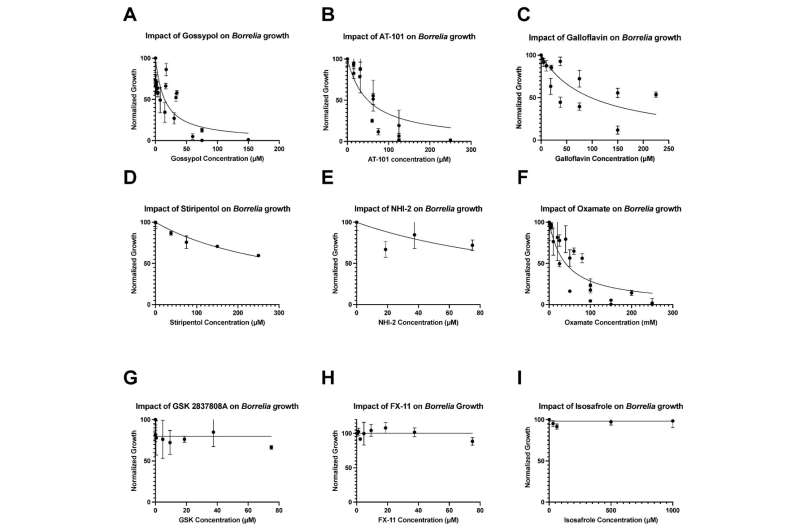This article has been reviewed according to Science X's editorial process and policies. Editors have highlighted the following attributes while ensuring the content's credibility:
fact-checked
trusted source
proofread
Research points to potential new medical therapy for Lyme disease

A medical therapy that inhibits the growth of cancer cells may one day be effective at treating Lyme disease, according to new research by a University of Massachusetts Amherst team at the New England Regional Center of Vector-borne Diseases (NEWVEC).
"It's a long way from something you're going to pick up at CVS, but these early findings are very encouraging," says vector-borne disease expert Stephen Rich, professor of microbiology, executive director of NEWVEC and senior author of the study published in the journal Pathogens.
Lyme disease is the most common vector-borne disease in the U.S., spread by infected deer ticks. The potentially debilitating illness, which is diagnosed in about 476,000 people each year in the U.S., doesn't always respond to antibiotics.
"There are people who have cases of Lyme disease that go on and on," Rich says. "So there's always interest in finding new therapies or new ways to inhibit the growth of the bacterium. And based on what we're seeing in the lab, this may be one of those ways."
The discovery began with an "aha" moment by then-Ph.D. candidate Patrick Pearson, who was working in Rich's lab, along with graduate student Adam Lynch. Pearson, co-author of the paper, is now a NEWVEC post-doctoral researcher at UMass Amherst. Lynch, lead author, is now a research fellow in the Department of Veterinary and Animal Sciences.
Tumor cells and Borrelia burgdorferi, the corkscrew-shaped bacterium that causes Lyme disease, share an unusual feature about the way they grow, Pearson noted and pondered. "It turns out that cancer cells and Borrelia both rely solely on glycolysis for their metabolism," Rich explains.
Glycolysis, in turn, is dependent on one molecule called lactate dehydrogenase, or LDH. Pearson wondered whether LDH inhibitors, which are used as drug therapies to target certain cancers, might also be an effective strategy against Lyme disease.
"It was a very clever idea," Rich says. "In principle, we thought these LDH inhibitors should work well to inhibit the growth of Lyme disease bacteria."
And in fact, in in vitro experiments, they did. "…a range of commercially available LDH inhibitors with various mechanisms of action and origins were tested on Borrelia in Culture," the paper states. "Of these inhibitors, gossypol, AT-101, and oxamate substantially impacted B. burgdorferi growth in vitro and represent promising candidates against Borrelia infections in vivo."
Rich says the research will continue at NEWVEC.
"These experiments were done outside of hosts. Now we need to carry this out in mouse models and, eventually, in people," Rich says.
The researchers note that this drug therapy may also be effective against another tick-borne disease, babesiosis, a malaria-like infection. "This has the potential to kill two birds with one stone," Rich says. "And that makes this discovery even more tantalizing."
More information: Adam Lynch et al, Lactate Dehydrogenase Inhibitors Suppress Borrelia burgdorferi Growth In Vitro, Pathogens (2023). DOI: 10.3390/pathogens12070962


















